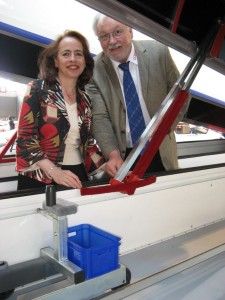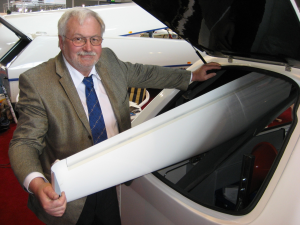Alfred and Agnes Spindelberger of Alfred Spindelberger Fahrzeugtechnik GmbH in Germany recently shared the latest developments regarding their  Cobra brand of trailers. As an owner of several trailers over the years (both Cobra and other brands) the features and attention to detail were definitely worth a closer look.
Cobra brand of trailers. As an owner of several trailers over the years (both Cobra and other brands) the features and attention to detail were definitely worth a closer look.
According to the pilot couple, the current trend in trailer design is fitting multi-span (15/18m or 18/20m) gliders in what would typically be considered trailers with a 15m chassis length. Their solution to storing multi-segment wings in a compact package is to place some of the wing pieces in the clamshell top, instead of trying to fit everything in the trailer bed.
This sounds deceptively simple, but hanging multiple components from the clamshell sides and ceiling (in addition to the usual horizontal stabilizer) results in a considerable unloaded-versus-loaded weight differential to the trailer top. The ensuing technical challenge is that the gas assist springs, if powerful enough to support a loaded clamshell top, would be difficult to compress once the top was unloaded. Conversely, if the gas springs are sized to counterbalance a regular clamshell, the top would be unable to stay open when laden with the extra items.
 Cobra’s practical solution is to place tandem gas struts on each side of the clamshell (see photo at left with Agnes and Alfred), each set fitted with a latching mechanism to allow selection between single or paired gas struts. Basically, all four struts are made active when pieces are stored in the clamshell and only two struts are active when the clamshell holders are empty (allowing the empty clamshell to be closed easily by one person).
Cobra’s practical solution is to place tandem gas struts on each side of the clamshell (see photo at left with Agnes and Alfred), each set fitted with a latching mechanism to allow selection between single or paired gas struts. Basically, all four struts are made active when pieces are stored in the clamshell and only two struts are active when the clamshell holders are empty (allowing the empty clamshell to be closed easily by one person).
In addition to the tandem gas struts, Agnes and Alfred pointed out new wingtip holsters and dual-stage wing-trolley catches in the front of the trailer. The hinged holsters swing inboard so that wing extensions can be easily removed through the front hatch (as demonstrated by Alfred in the photo below). The trolley catches, to keep the wings from shifting backwards during transport, have become necessary in recent years due to the snappy acceleration of tow vehicles.
According to Alfred, trailer design is increasingly defined by the tow vehicle  accelerating condition rather than the braking condition. This is exacerbated by the simple fact that wings (and fuselages) are more difficult to constrain in the aft direction. The slender wings on newer sailplanes usually have tips that offer few robust features to secure to or minimum surface area to rest against tailgate pads – thus the choice to channel the acceleration forces from the beefier root end of the wings into the trolleys. The dual-stage catches are clever in that they also allow the clamshell to be lowered without risk of damaging an out-of-position wing trolley. Only after the wings are pushed sufficiently into their proper storage positions do the spring-loaded catches secure the trolleys at the front of the trailer.
accelerating condition rather than the braking condition. This is exacerbated by the simple fact that wings (and fuselages) are more difficult to constrain in the aft direction. The slender wings on newer sailplanes usually have tips that offer few robust features to secure to or minimum surface area to rest against tailgate pads – thus the choice to channel the acceleration forces from the beefier root end of the wings into the trolleys. The dual-stage catches are clever in that they also allow the clamshell to be lowered without risk of damaging an out-of-position wing trolley. Only after the wings are pushed sufficiently into their proper storage positions do the spring-loaded catches secure the trolleys at the front of the trailer.
The always-smiling Agnes and Alfred also highlighted several other details such as a new spring-loaded latch for the tailgate, super handy storage bins on each wing trolley (blue plastic container in the photo), sidewall latches to tether the wing trolleys in place when towing an empty trailer, and a new tailwheel lift-lever for motor gliders (requiring 30% less effort to raise), not to mention their regular assortment of proven options. All told, some fine features to properly store a precious sailplane and to put on one’s wish list. The adage about pilots naïvely overlooking the trailer when purchasing their first sailplane and having a newfound focus on the anhänger when buying their second segelflugzeug becomes pretty understandable after seeing such nice refinements in trailer design.






